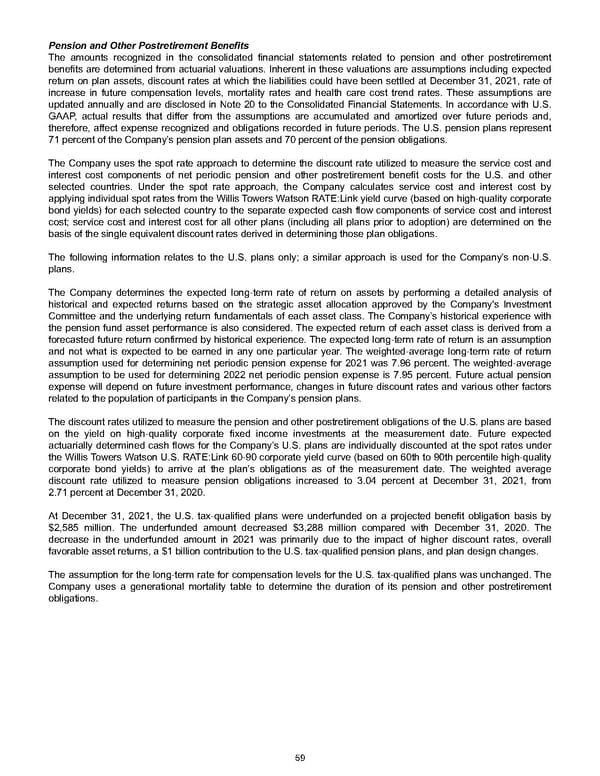Pension and Other Postretirement Benefits The amounts recognized in the consolidated financial statements related to pension and other postretirement benefits are determined from actuarial valuations. Inherent in these valuations are assumptions including expected return on plan assets, discount rates at which the liabilities could have been settled at December 31, 2021 , rate of increase in future compensation levels, mortality rates and health care cost trend rates. These assumptions are updated annually and are disclosed in Note 20 to the Consolidated Financial Statements. In accordance with U.S. GAAP, actual results that differ from the assumptions are accumulated and amortized over future periods and, therefore, affect expense recognized and obligations recorded in future periods. The U.S. pension plans represent 71 percent of the Company’s pension plan assets and 70 percent of the pension obligations. The Company uses the spot rate approach to determine the discount rate utilized to measure the service cost and interest cost components of net periodic pension and other postretirement benefit costs for the U.S. and other selected countries. Under the spot rate approach, the Company calculates service cost and interest cost by applying individual spot rates from the Willis Towers Watson RATE:Link yield curve (based on high-quality corporate bond yields) for each selected country to the separate expected cash flow components of service cost and interest cost; service cost and interest cost for all other plans (including all plans prior to adoption) are determined on the basis of the single equivalent discount rates derived in determining those plan obligations. The following information relates to the U.S. plans only; a similar approach is used for the Company’s non-U.S. plans. The Company determines the expected long-term rate of return on assets by performing a detailed analysis of historical and expected returns based on the strategic asset allocation approved by the Company's Investment Committee and the underlying return fundamentals of each asset class. The Company’s historical experience with the pension fund asset performance is also considered. The expected return of each asset class is derived from a forecasted future return confirmed by historical experience. The expected long-term rate of return is an assumption and not what is expected to be earned in any one particular year. The weighted-average long-term rate of return assumption used for determining net periodic pension expense for 2021 was 7.96 percent . The weighted-average assumption to be used for determining 2022 net periodic pension expense is 7.95 percent. Future actual pension expense will depend on future investment performance, changes in future discount rates and various other factors related to the population of participants in the Company’s pension plans. The discount rates utilized to measure the pension and other postretirement obligations of the U.S. plans are based on the yield on high-quality corporate fixed income investments at the measurement date. Future expected actuarially determined cash flows for the Company’s U.S. plans are individually discounted at the spot rates under the Willis Towers Watson U.S. RATE:Link 60-90 corporate yield curve (based on 60th to 90th percentile high-quality corporate bond yields) to arrive at the plan’s obligations as of the measurement date. The weighted average discount rate utilized to measure pension obligations increased to 3.04 percent at December 31, 2021 , from 2.71 percent at December 31, 2020 . At December 31, 2021 , the U.S. tax-qualified plans were underfunded on a projected benefit obligation basis by $2,585 million. The underfunded amount decreased $3,288 million compared with December 31, 2020 . The decrease in the underfunded amount in 2021 was primarily due to the impact of higher discount rates, overall favorable asset returns, a $1 billion contribution to the U.S. tax-qualified pension plans, and plan design changes. The assumption for the long-term rate for compensation levels for the U.S. tax-qualified plans was unchanged. The Company uses a generational mortality table to determine the duration of its pension and other postretirement obligations. 59
 Annual Report Page 68 Page 70
Annual Report Page 68 Page 70